How to drill a well on water in the countryside
How to drill a well for arranging autonomous water supply systems? What equipment is used for this and what factors affect the choice of the type of water well? According to what parameters is the cost of the project as a whole determined? These and other questions will be answered within this article.

Basic drilling information
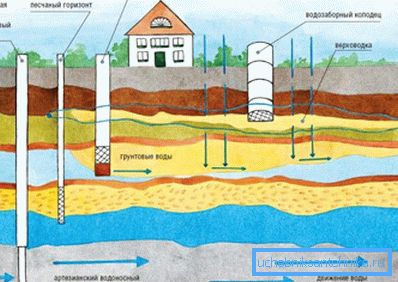
How and what bore holes in the water depends on the depth of the aquifer. Therefore, before calculating the budget of work, it is necessary to determine the location of the aquifer with respect to the area.
Such information can be obtained in special services engaged in conducting geodetic surveys or by contacting the nearest neighbor who drilled a well in his area.
The approximate location of the aquifers is as follows:
- "Flood" - the first layer, lying no deeper than 6-7 meters. Most often, water from such a source is unsuitable for use without special cleaning and softening. As a rule, these wells are used for the extraction of soil water used in technical needs.
- The second aquifer is located at a depth of 15-20 meters. The groundwater produced in this way is clean and, therefore, it can be used not only for technical purposes, but also for cooking.
- The highest quality water that you can get from a well at the summer cottage is located at a depth of 30 to 60 meters. Such water is less in need of careful multi-stage cleaning.
- The deepest are artesian wells, since the aquifer is located at the level of the fractured-cross horizons, that is, at a depth of 200-250 meters
Once again, we note that the figures given are data confirmed by statistics, but in reality the situation may be different. So, for example, there are frequent cases when at a depth of over 60 meters there was not groundwater, but “quicksand”.
Important: In regions with an unfavorable environmental situation, the suitability of water for human consumption is in doubt, regardless of the depth of the drilling of the well. Again, the quality and quantity of water produced may depend on weather conditions. Low rainfall during the year and dry summer guarantee an increased likelihood that the water in the well will be low and it will not be as clean as in years with heavy rainfall.
Drilling methods
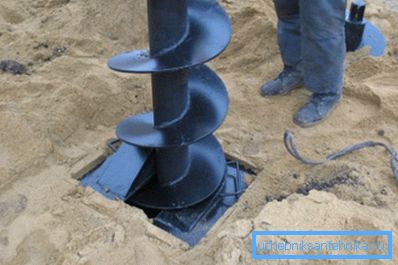
How well water wells are drilled depends largely on the budget allocated for the project, on the number of access roads and on the free space on the site.
Drilling by the method of implementation can be divided into two types: manual and mechanized.

Manual work involves the use of such equipment as:
- tripod, which is assembled from improvised means at the site;
- manual or electrified winch, raising and lowering the drill;
- set of the drill with replaceable bars;
- pump for pumping the finished well.

Mechanized drilling is performed using specialized installations driven by electric motors or torque transmitted from an automotive drive. For ease of use, mechanized installations are mounted on the wheeled chassis of trucks.
The use of mechanical installations facilitates and simplifies the achievement of the task in comparison with the manual method. But mechanized drilling requires from the performer professional skills and appropriate qualifications. Again, the price of buying or renting a mobile drilling rig significantly increases the cost of the finished well.
Manual methods
Drilling with their own hands is characterized by simplicity and cheapness. The advantages of manual methods are the ability to do without the use of special equipment and sophisticated equipment, which is especially important when access roads are not provided on the site.
Currently, the following methods of laying the source for the construction of autonomous water supply systems are commonly used:
- Abyssinian method;
- shock-rope method;
- auger drilling technique.
We will tell about each of these methods in more detail.
Abyssinian method
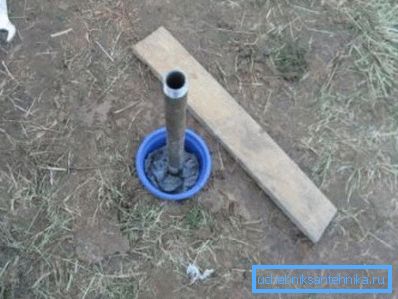
The Abyssinian method of drilling wells is the most primitive and at the same time the most inexpensive. This method was tested for many centuries and was used initially in areas where groundwater does not lie very deeply.
The equipment used is a hollow metal core inside with sharpened edges. The device resembles a medical needle with a cross-sectional diameter of about 3-5 cm. The device is held in a vertical position, while its upper part is struck with a sledgehammer.
After the rod has penetrated to the required depth, it is pulled out using special handles. The soil selected from the well is inside the rod.
The advantage of this method is that it is possible to drill without any preparation, because during a given time it is possible to exhaust a large area and thus, sooner or later, to detect water. Among the shortcomings, we note the possibility of drawing water from the “floating”, but not deeper.
Important: When setting up an Abyssinian well, pumping equipment can only be used with a surface location.
Shock method

Such a method is universally used both by ordinary summer residents and owners of country houses, and by small companies engaged in the construction of autonomous water supply systems.
The method assumes the need to use specialized equipment:
- metal tripod;
- driving glass;
- cable;
- winch.
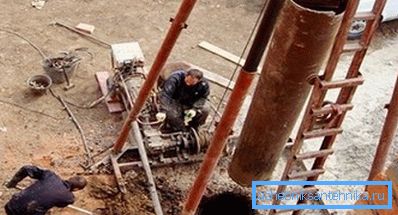
The drilling process is as follows:
- On the site is determined by the lowest place.
- There is also a tripod, which can be assembled independently from available means or leased.
- On the tripod itself or near it a winch is mounted, to which the cable is attached.
- A ram is attached to the cable, which is a hollow tube with sharpened edges.
- Through the winch, the tumbler rises under the top of the tripod and lowers with force under the weight of its weight.
- The clogging continues until the glass enters the ground to the very top, after which the glass is dismantled and its internal volume is cleared of compressed soil.
- Further, the glass can be expanded with additional rods to achieve greater depth of drilling.
This method of drilling is advisable in areas with a soft and viscous soil. If at the site the soil is dry and loose, it will not linger in the cavity of the driving glass. In order to drill efficiently on dry soils, instead of glass you can use a shell, which, regardless of the condition of the soil, lifts the rock from the well to the surface.
It is necessary to take into account that the shock-cable drilling method is the most protracted, time-consuming and expensive of all known methods of creating wells. But such costs are fully justified, since the result of drilling is very high quality.
Auger drilling method
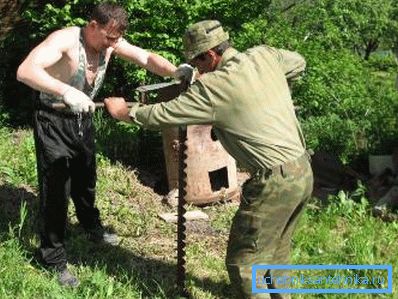
This is the easiest fast and inexpensive way to drill a well in a limited area. Auger bit is used as the main working tool. The tool looks similar to a large drill.
The principle of drilling is as follows:
- At the site determine the place with the lowest location;
- Install the drill perpendicular to the horizon;
- Two people take up the handle mounted at the top of the drill, and spin the tool in a circle in a clockwise direction. The drill, due to the presence of a bladed auger, itself destroys the rock, biting into the ground.
- After the drill enters the ground to the top, it is increased by additional rods, which allows you to make the wellbore of the required depth.
Important: The use of a spiral drill is advisable when drilling a wellbore in gravel and loamy soils. If the area is dominated by loose and sandy soils, the laying of the well is performed using a drill-spoon in a shape resembling a cylinder with a certain number of spiral holes.
Mechanical drilling methods

The mechanical drilling methods include laying a well using heavy machinery, equipped with carbide-tipped drill bits. The use of such methods is the best solution to achieve the most buried aquifers.
Wells laid using mechanized drilling rigs are characterized not only by high productivity, but also by excellent water quality.
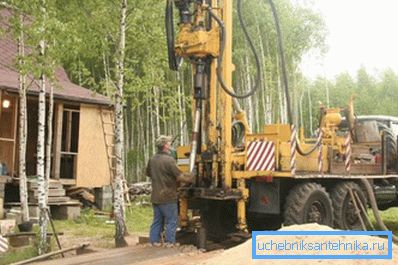
- Core drilling - This is an effective technique that is relevant in the construction of wells with a depth of up to 1000 m. The method is relevant in relation to the sample of rocks. Drilling is performed by means of a diamond core bit.
Among the advantages of the method, we note the high speed of penetration of hard rocks, compactness and maneuverability of drilling rigs. In addition, the method is characterized by high efficiency, since in the process of drilling the rock is destroyed not by a solid but by a ring face. As a result, the development of soil is carried out with a solid core (core).
Among the disadvantages of this method of drilling, we note a small borehole diameter (not more than 16 cm) and also intensive wear of diamond crowns, which negatively affects the cost of the finished result. For example, the price of penetration for 1 meter is up to 500 rubles. Calculate the approximate cost of the wellbore will be easy.

- Mechanical rotary drilling - another method that requires the use of high-tech equipment. The main working tool is a chisel mounted on a drill, rotating around its axis, projectile.
The projectile is driven by a rotary mechanism. This method of drilling is particularly in demand when laying aquifers on very hard soils. The advantages of the method also include high performance in soil sampling and, as a result, short deadlines for the implementation of the whole process.
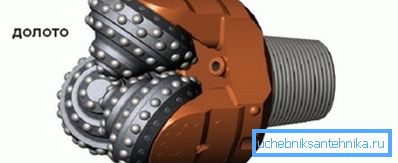
The rotary drilling method is guaranteed to achieve the deepest aquifers with the cleanest water. This water does not contain iron compounds, and therefore it will be possible to save on the use of multi-stage filtration systems.
However, this technology has some drawbacks, among which is a high consumption of water and clay used to prepare the washing solution. Again, clay particles can penetrate when the wellbore is flushed into the aquifer.
The approximate price of 1 meter of the trunk is about 1500-2000 rubles.

- Auger drilling - this is probably the easiest way in which a blade-screw cutter is used, which opens the rock and goes deep. Passing deep into the ground, the tool automatically pulls the selected rock from the trunk to the surface.
Equipment for mechanized auger drilling is installed on a wheel platform or on a truck chassis. Due to the relatively small size and mobility of installations, auger drilling is used in suburban areas or near country houses with a limited number of access roads.
Tips that will be useful when drilling wells at the dacha
From the very beginning, try to take into account the prospect of a change in water use parameters due to an increase in consumers or for other reasons. Considering that drilling a well in any case is not an expensive process, it is advisable to calculate your needs for several years ahead from the very beginning so that you don’t have to drill again.
You must select the type of well that will meet your needs. It is not necessary to form an autonomous water supply system, based only on the available budget or on the characteristics of the site. The water well is not made for one year, so it is advisable to choose the best.
Equipping the finished well, do not save on the purchase of equipment, as a high-quality preparation system will not only provide clean water, but also a long service life of plumbing equipment and a number of household appliances.
Conclusion
As you can see, the drilling instruction is not easy. But if you wish, you can choose the way in which the task can be performed independently. Responsible approach to each stage of drilling, the use of high-quality equipment and the exact adherence to technological prescriptions are all components of your success. In order to simplify the task, watch the video in this article.